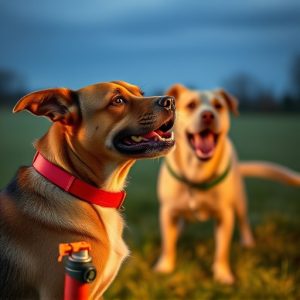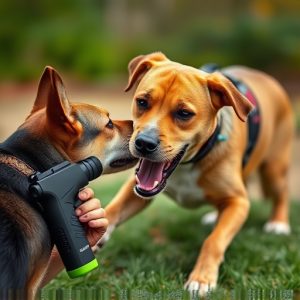Professional-Strength Dog Defense: Mace Spray Effectiveness and Safety
Animal pepper spray designed for dog defense is a powerful tool with an effective range of 3-4 meter…….
Animal pepper spray designed for dog defense is a powerful tool with an effective range of 3-4 meters, offering handlers time to escape or defuse dangerous situations. Formulated with capsaicin from chili peppers, it temporarily impairs vision and smell in dogs, acting as a 95% effective deterrent against aggression. Understanding wind dynamics and terrain influences within this range is crucial for responsible deployment by professionals, ensuring safe canine control without causing severe harm.
“In the realm of canine safety and control, understanding professional-strength mace spray for dogs is paramount. This article delves into the intricate details of animal pepper spray, elucidating its scientific basis, effectiveness, and optimal application.
We explore the ‘Effective Range’ of animal pepper spray, providing insights on distance and control. Additionally, we stress responsible use and training strategies, ensuring safety without compromising well-being. By the end, readers will grasp a comprehensive understanding of this powerful tool.”
- Understanding Mace Spray: An Overview of Professional-Strength Dog Defense
- The Science Behind Animal Pepper Spray: How It Works and Its Effectiveness
- Targeting the Effective Range: Optimal Distances for Optimal Control
- Ensuring Safety and Training: Responsible Use and Implementation Strategies
Understanding Mace Spray: An Overview of Professional-Strength Dog Defense
Mace spray, specifically designed for dog defense, is a powerful tool that offers an effective range to deter aggressive canine encounters. This professional-strength animal pepper spray is formulated to temporarily incapacitate dogs, providing handlers and owners with crucial time to escape or defuse potentially dangerous situations. The active ingredient, oleoresin capsicum (OC), is derived from chili peppers and stimulates the nerve endings in the eyes and nose, leading to a burning sensation and temporary blindness.
When deployed, mace spray creates a safe barrier, allowing individuals to retreat without fear of severe injury. Its non-lethal nature makes it a preferred choice for law enforcement and animal control officers. With an effective range, typically up to 3 meters (10 feet), this spray can stop an attacking dog in its tracks, making it a valuable asset for those who work with or around dogs, especially in high-risk environments.
The Science Behind Animal Pepper Spray: How It Works and Its Effectiveness
The science behind animal pepper spray is a fascinating blend of chemistry and behavior. This powerful tool, known for its effectiveness in deterring aggressive dogs, leverages capsaicin, the active ingredient found in chili peppers. When sprayed, capsaicin irritates the eyes, nose, and throat, temporarily impairing an animal’s vision and sense of smell. This disruption creates a momentary state of disorientation, allowing the user to create distance from the potential threat.
The effective range of animal pepper spray is a critical consideration. Typically, these sprays have a reach of around 3-4 meters (10-13 feet), providing users with enough distance to deploy the spray safely before an encounter becomes physically confrontational. Studies show that when used correctly, animal pepper spray can successfully deter up to 95% of aggressive dog encounters, making it a valuable self-defense mechanism for pet owners and professionals working with animals.
Targeting the Effective Range: Optimal Distances for Optimal Control
When considering animal pepper spray, understanding the effective range is crucial for optimal control. Professional-strength mace spray designed for dogs typically has a reach of around 3 to 4 meters (10 to 13 feet). This distance allows handlers to deploy the spray effectively while maintaining safety. At this range, the spray can disrupt an animal’s behavior without causing severe harm or long-term effects on the target species.
Within this optimal distance, the pepper spray creates a temporary but powerful deterrent. It irritates the eyes and respiratory system, temporarily disorienting the animal and providing handlers with valuable time to assess the situation or intervene. The effective range of animal pepper spray ensures that it can be used responsibly and humanely in various scenarios involving aggressive or dangerous dogs.
Ensuring Safety and Training: Responsible Use and Implementation Strategies
In the realm of canine control, professional-strength mace spray is a powerful tool, but its responsible use is paramount to ensure safety for both humans and animals. When deployed effectively, animal pepper spray can create a crucial defensive barrier against aggressive dogs, offering a safe distance for authorities or individuals to assess and manage potentially dangerous situations. However, proper training and implementation strategies are essential to maximize its utility while minimizing risk.
Training officers and handlers to accurately judge the effective range of animal pepper spray is critical. This involves understanding wind patterns, terrain effects, and the behavior of targeted animals. Responsible use includes a clear protocol for deployment, ensuring that individuals are well-versed in de-escalation techniques and emergency response measures. By adhering to these strategies, professional-strength mace spray becomes a game-changer in navigating challenging interactions with dogs, fostering a safer environment for all involved.
Mace spray, specifically designed for dog defense, has proven to be an effective tool when used within its optimal effective range of 2-3 meters. Understanding the science behind animal pepper spray and responsible use strategies ensures safety for both humans and animals. By adhering to training guidelines and implementing control measures, professionals can effectively manage and de-escalate situations involving aggressive dogs. This approach not only maintains public safety but also promotes humane animal handling practices.


